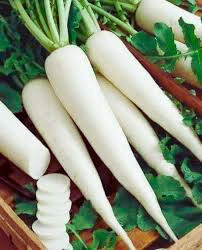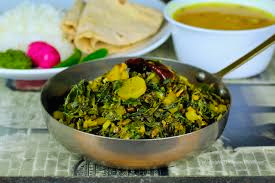Health Benefits and Side Effects of Radishes and more uses.

Radishes, a crunchy and versatile root vegetable, have been a staple in human diets for centuries. Packed with essential nutrients, they offer numerous health benefits but may also cause certain side effects if not consumed in moderation.
Health Benefits of Radishes
1. Rich in Nutrients: Radishes are a good source of vitamins C and K, folate, and minerals like potassium, which are essential for overall health.
2. Aids Digestion: The high fiber content in radishes promotes healthy digestion, prevents constipation, and supports regular bowel movements.
3. Boosts Immunity: Radishes are rich in vitamin C, which strengthens the immune system and helps fight infections.
4. Promotes Heart Health: Antioxidants in radishes help reduce inflammation and protect against cardiovascular diseases.
5. Supports Skin Health: The vitamin C in radishes aids in collagen production, contributing to healthy, glowing skin.
6. Helps with Weight Management: Radishes are low in calories and high in fiber, making them an excellent choice for those looking to manage their weight.

Health Benefits and Side Effects of Radishes and more uses.
Potential Side Effects of Radishes
While radishes are generally safe to eat, overconsumption or individual sensitivities can lead to certain side effects:
1. Upset Stomach: Eating too many radishes may cause bloating, gas, or diarrhea in some individuals.
2. Allergic Reactions: Some people may experience allergic reactions to radishes, such as rashes, itching, or swelling.
3. Thyroid Concerns: Excessive consumption of radishes may interfere with thyroid function, particularly in individuals with pre-existing thyroid conditions.
Health Benefits and Side Effects of Radishes and more uses.
When to Avoid Radishes
1. Kidney Stones: People prone to kidney stones should consume radishes in moderation, as they may increase the risk of stone formation.
2. Diabetes: Radishes can lower blood sugar levels. Diabetic individuals should monitor their blood sugar closely when consuming radishes.
How to Incorporate Radishes into Your Diet
Radishes can be enjoyed in a variety of ways:
Eaten raw in salads or as a crunchy snack.
Added to sandwiches or wraps for extra texture.
Cooked in stir-fries or roasted for a milder flavor.
Pickled or used to make flavorful chutneys.
Conclusion
Radishes are a highly nutritious and versatile vegetable that can provide numerous health benefits when consumed in moderation. However, individuals with specific health conditions should consult a healthcare professional before incorporating large amounts of radishes into their diet.

Health Benefits and Side Effects of Radishes and more uses.
Would you like more tips on preparing radishes or information about their nutritional value?
Here are some simple and tasty recipes using radishes:
1. Radish Salad
Ingredients:
1 cup radishes (thinly sliced)
1 cucumber (sliced)
1 tablespoon olive oil
1 teaspoon lemon juice
Salt and pepper to taste
Fresh herbs (like parsley or dill, optional)
Instructions:
1. Mix sliced radishes and cucumber in a bowl.
2. Drizzle with olive oil and lemon juice.
3. Season with salt, pepper, and fresh herbs.
4. Toss well and serve fresh
2. Radish Stir-Fry
Ingredients:
1 cup radish slices
1 small onion (sliced)
1-2 garlic cloves (minced)
1 teaspoon cumin seeds
1 tablespoon oil
Salt and spices to taste (like turmeric or chili powder)
Instructions:
1. Heat oil in a pan and add cumin seeds. Let them splutter.
2. Add garlic and onion, sauté until golden.
3. Add radishes, salt, and spices. Cook for 5-7 minutes until tender.
4. Serve as a side dish with rice or bread.
3. Radish Paratha (Flatbread)
Ingredients:
1 cup grated radish
1 cup wheat flour
1/2 teaspoon cumin powder
1/2 teaspoon chili powder
Salt to taste
Water (as needed)
Oil or butter for cooking
Instructions:
1. Squeeze out water from the grated radish.
2. Mix radish with flour, spices, and a bit of water to form a dough.
3. Roll out flatbreads and cook on a hot pan with oil or butter until golden.
4. Serve hot with yogurt or pickles.
4. Pickled Radishes
Ingredients:
1 cup radishes (sliced)
1/2 cup vinegar
1/2 cup water
1 teaspoon sugar
1/2 teaspoon salt
Instructions:
1. Heat vinegar, water, sugar, and salt until dissolved.
2. Pour over radish slices in a jar.
3. Let sit for at least an hour (or overnight) before serving.
5. Radish Soup
Ingredients:
2 cups radishes (chopped)
1 small potato (chopped)
1 onion (chopped)
2 cups vegetable stock
1 tablespoon butter or oil
Salt and pepper to taste
Instructions:
1. Heat butter/oil in a pot and sauté onion.
2. Add radishes, potato, and stock. Simmer for 15 minutes.
3. Blend until smooth, season, and serve warm.

Health Benefits and Side Effects of Radishes and more uses.
Radish can indirectly help with reducing belly fat due to its nutritional properties:
1. Low in Calories: Radish is low in calories, making it a good addition to a weight-loss diet.
2. Rich in Fiber: Its high fiber content promotes better digestion and keeps you full for longer, reducing overeating.
3. Detoxifying Properties: Radishes help flush out toxins and improve liver function, which can support fat loss.
4. Boosts Metabolism: Radishes contain nutrients that help boost metabolism, aiding in weight management.
5. Low Glycemic Index: They do not cause a spike in blood sugar levels, which is essential for reducing fat storage.
Including radish in salads, soups, or juices can be beneficial as part of a balanced diet.